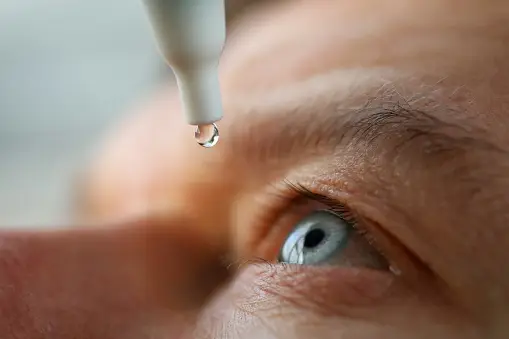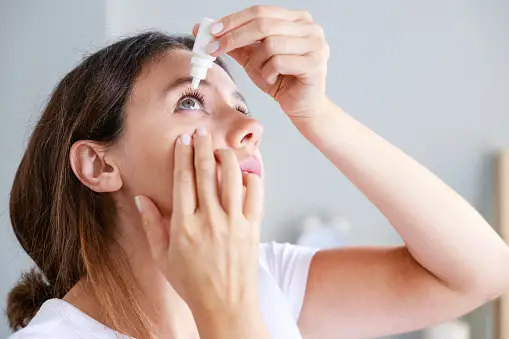Dry eye syndrome, also known as dry eye disease, is a prevalent ocular condition affecting millions worldwide. It occurs when the eyes fail to maintain a healthy layer of tears to lubricate the surface, leading to discomfort, irritation, and sometimes even damage. The tears are essential not only for lubrication but also for nourishing and protecting the front surface of the eye. When this balance is disrupted, individuals may experience symptoms such as stinging or burning sensations, redness, sensitivity to light, and in some cases, blurred vision.
Various factors contribute to dry eye, including age, environmental conditions (such as dry climates or air conditioning), prolonged screen use, certain medications, and underlying health conditions like autoimmune diseases. Understanding the underlying causes and symptoms is crucial for both diagnosis and effective management.
Treatment approaches range from over-the-counter lubricating eye drops to prescription medications and lifestyle adjustments. Additionally, advanced treatments like punctal plugs (tiny devices inserted into tear ducts to block drainage) or in severe cases, surgery, may be considered. Managing dry eye not only improves comfort but also protects the long-term health of the eyes.
Table of Contents
Types of Dry Eye

Dry eye syndrome encompasses several types, each characterized by different underlying causes and contributing factors. Understanding these types is essential for accurate diagnosis and appropriate treatment:
- Aqueous Deficient Dry Eye: This type occurs when the lacrimal glands fail to produce enough aqueous (watery) component of tears. It can be caused by age-related changes, certain medications, systemic diseases like Sjögren’s syndrome, or damage to the lacrimal glands.
- Evaporative Dry Eye: In this type, there’s sufficient tear production, but the tears evaporate too quickly due to abnormalities in the lipid (oil) layer of the tears. This often results from meibomian gland dysfunction (MGD), where the glands responsible for producing oil are blocked or dysfunctional. Factors such as aging, contact lens wear, or environmental conditions can exacerbate evaporative dry eye.
- Mixed Dry Eye: Some individuals may experience a combination of both aqueous deficient and evaporative dry eye, complicating the treatment approach.
- Non-Sjögren’s Dry Eye: This refers to dry eye not associated with Sjögren’s syndrome, an autoimmune disorder that affects the body’s moisture-producing glands.
- Secondary Dry Eye: Certain medications (such as antihistamines or decongestants), medical conditions (like diabetes or thyroid disorders), and environmental factors (such as smoke or windy conditions) can contribute to dry eye as a secondary effect.
Each type of dry eye may present with varying symptoms and require tailored treatment approaches. Diagnosis typically involves a comprehensive eye examination, evaluation of tear production and quality, and consideration of underlying health conditions.
Symptoms of Dry Eye

Dry eye syndrome manifests through a variety of symptoms, which can range from mild discomfort to significant irritation and vision disturbances. Recognizing these symptoms is crucial for early diagnosis and effective management:
- Dryness: A persistent sensation of dryness or grittiness in the eyes is a hallmark symptom of dry eye. This may feel like something is in the eye or a general feeling of dryness.
- Redness: Eyes affected by dryness may appear red or bloodshot due to irritation and inflammation of the conjunctiva (the clear membrane covering the white part of the eye).
- Stinging or Burning Sensation: Individuals with dry eye often experience a sensation of burning, stinging, or itching in the eyes, particularly after prolonged periods of focusing on screens or in dry environments.
- Watery Eyes: Paradoxically, dry eye can sometimes cause an overproduction of reflex tears as the eyes try to compensate for dryness. However, these tears do not adequately lubricate the eyes and can lead to temporary relief followed by continued discomfort.
- Sensitivity to Light: Known as photophobia, sensitivity to light can worsen with dry eye, making it uncomfortable to be in brightly lit environments.
- Blurred Vision: Vision may fluctuate or become temporarily blurred, especially during activities that require sustained visual attention like reading or using a computer.
- Difficulty with Contact Lenses: Contact lens wearers may experience discomfort or find it challenging to wear lenses for extended periods due to insufficient lubrication of the eyes.
- Eye Fatigue: Dry eye can contribute to eye strain and fatigue, particularly after prolonged visual tasks, which may affect productivity and overall comfort.
- Mucus Discharge: Some individuals with dry eye may notice stringy mucus in or around the eyes, which can be a result of inadequate tear production or quality.
- Eye Pain: In severe cases, dry eye can cause actual pain or a feeling of pressure in the eyes, impacting daily activities and quality of life.
These symptoms can vary in intensity and may be intermittent or persistent depending on the underlying cause and individual factors. Seeking professional evaluation by an eye care specialist is recommended for accurate diagnosis and tailored treatment.
Causes of Dry Eye Syndrome

Dry eye syndrome can result from a combination of factors that affect the quantity or quality of tears produced, leading to inadequate lubrication of the eyes. Understanding these causes is essential for effective management and treatment:
- Age: Advancing age is a significant risk factor for dry eye syndrome. As people get older, tear production tends to decrease, and tear composition may change, making older adults more susceptible to dryness and irritation.
- Gender: Hormonal changes, particularly in women due to pregnancy, oral contraceptives, or menopause, can affect tear production and quality, making women more prone to dry eye.
- Environmental Factors: Exposure to dry or windy climates, air conditioning, smoke, or low humidity levels can accelerate tear evaporation and contribute to dry eye symptoms.
- Screen Use: Prolonged use of digital screens (computers, smartphones, tablets) reduces blink frequency and can lead to incomplete blinking, which in turn affects tear distribution and stability.
- Medical Conditions: Certain systemic diseases and health conditions can contribute to dry eye syndrome, including diabetes, rheumatoid arthritis, thyroid disorders, and autoimmune diseases like Sjögren’s syndrome.
- Medications: Antihistamines, decongestants, antidepressants, hormone replacement therapies, and medications for high blood pressure and acne can decrease tear production or quality, exacerbating dry eye symptoms.
- Eyelid Problems: Conditions such as blepharitis (inflammation of the eyelids) and meibomian gland dysfunction (MGD) can disrupt the production of oils needed for tear stability, leading to evaporative dry eye.
- Contact Lens Wear: Improper fitting or prolonged use of contact lenses can lead to reduced tear production and increase the risk of dry eye symptoms.
- Refractive Eye Surgeries: Procedures such as LASIK and PRK can temporarily reduce tear production and cause dry eye symptoms as the eyes heal.
- Nutritional Deficiencies: Inadequate intake of essential fatty acids and vitamin A, which are crucial for maintaining healthy tears, can contribute to dry eye.
- Smoking: Smoking and exposure to secondhand smoke can increase the risk and severity of dry eye symptoms.
Identifying the specific causes and underlying factors contributing to dry eye is crucial for determining the most appropriate treatment approach. A comprehensive evaluation by an eye care professional can help diagnose the condition and develop a personalized management plan.
Risk Factors
Dry eye syndrome can develop due to a combination of factors that increase the likelihood of experiencing symptoms. Understanding these risk factors helps in identifying individuals who may be more susceptible to developing dry eye:
- Age: Advancing age is a significant risk factor for dry eye syndrome. Tear production tends to decrease with age, and tear composition may change, leading to increased dryness and discomfort.
- Gender: Women are more likely than men to develop dry eye, particularly due to hormonal changes associated with pregnancy, oral contraceptives, and menopause.
- Medical Conditions: Certain systemic diseases and health conditions increase the risk of dry eye, including diabetes, rheumatoid arthritis, thyroid disorders, and autoimmune diseases such as Sjögren’s syndrome.
- Medications: Use of medications such as antihistamines, decongestants, antidepressants, hormone replacement therapies, and medications for high blood pressure and acne can decrease tear production or quality, contributing to dry eye symptoms.
- Environmental Factors: Exposure to dry or windy climates, air conditioning, smoke, and low humidity levels can accelerate tear evaporation and worsen dry eye symptoms.
- Screen Use: Prolonged use of digital screens (computers, smartphones, tablets) reduces blink frequency and can lead to incomplete blinking, which affects tear distribution and stability.
- Contact Lens Wear: Improper fitting, extended wear, or inadequate lens care can contribute to dry eye symptoms by reducing tear production and causing irritation.
- Eyelid Problems: Conditions such as blepharitis (inflammation of the eyelids) and meibomian gland dysfunction (MGD) can disrupt the production of oils needed for tear stability, leading to evaporative dry eye.
- Refractive Eye Surgeries: Procedures such as LASIK and PRK can temporarily decrease tear production and cause dry eye symptoms during the healing process.
- Nutritional Deficiencies: Inadequate intake of essential fatty acids and vitamin A, which are crucial for maintaining healthy tears, can increase the risk of dry eye.
- Smoking: Smoking and exposure to secondhand smoke can irritate the eyes and increase the risk and severity of dry eye symptoms.
Recognizing these risk factors can help individuals and healthcare providers identify those at higher risk for developing dry eye syndrome. Implementing preventive measures and early intervention strategies can help manage and reduce the impact of dry eye on daily life and ocular health.
Diagnosis of Dry Eye Syndrome

Diagnosing dry eye syndrome involves a thorough assessment by an eye care professional, typically an optometrist or ophthalmologist. The process may include the following steps:
- Patient History: The healthcare provider will start by asking about your symptoms, medical history, medications you’re taking, and any environmental factors that may contribute to dry eye.
- Symptom Evaluation: Describing your symptoms in detail helps in understanding the nature and severity of dry eye discomfort, such as dryness, burning, itching, or sensitivity to light.
- Visual Acuity Test: A basic eye test to measure how well you see at various distances using an eye chart.
- Tear Film Assessment: Several methods may be used to evaluate the quantity and quality of your tears:
- Schirmer’s Test: Measures tear production by placing small strips of filter paper under the lower eyelids to see how much moisture is absorbed over a certain period.
- Tear Break-Up Time (TBUT): Assesses how quickly your tears evaporate by observing how long it takes for dry spots to appear on the cornea after blinking.
- Fluorescein Staining: Uses a special dye (fluorescein) to highlight damaged areas on the cornea and evaluate tear distribution.
- Meibomian Gland Evaluation: Checking the function and structure of the meibomian glands in your eyelids, which produce the oil component of tears, often done through clinical examination or imaging techniques.
- Additional Tests: In some cases, additional tests or imaging techniques may be used to assess tear production, tear film stability, or the health of the ocular surface.
- Underlying Conditions: Since dry eye can be associated with systemic conditions like Sjögren’s syndrome or autoimmune diseases, your healthcare provider may recommend blood tests or refer you to a specialist for further evaluation if necessary.
Once diagnosed, your healthcare provider will discuss treatment options tailored to your specific condition, which may include artificial tears, prescription medications, lifestyle adjustments, or procedures to improve tear production or quality.
Treatment of Dry Eye Syndrome

The treatment of dry eye syndrome aims to alleviate symptoms, improve tear quality and quantity, and prevent complications. The specific approach may vary depending on the severity of symptoms, underlying causes, and individual factors. Here are common treatment options:
- Artificial Tears: Over-the-counter artificial tear drops or ointments provide lubrication and temporarily relieve dryness and discomfort. These can be used as needed throughout the day.
- Prescription Eye Drops: Medications such as cyclosporine (Restasis), lifitegrast (Xiidra), or corticosteroid eye drops may be prescribed to reduce inflammation and improve tear production or quality.
- Lipid-Based Tear Substitutes: Eye drops containing lipids (fats) can help stabilize the tear film and reduce evaporation, particularly beneficial for those with evaporative dry eye due to meibomian gland dysfunction.
- Punctal Plugs: Tiny silicone or collagen plugs may be inserted into the tear ducts (puncta) to block drainage and conserve tears on the ocular surface, increasing moisture and reducing symptoms.
- Lifestyle and Environmental Modifications: Adjusting environmental factors such as increasing humidity, using protective eyewear in windy or dry conditions, and taking breaks during prolonged screen use can help manage dry eye symptoms.
- Eyelid Hygiene: Regular cleaning of the eyelids and proper care of eyelashes can help manage conditions like blepharitis and improve the function of meibomian glands.
- Nutritional Supplements: Omega-3 fatty acids, found in fish oil supplements, may help improve tear quality and reduce inflammation in some individuals with dry eye.
- Thermal Pulsation Therapy: This procedure applies heat and gentle pressure to the eyelids to help liquefy and release oils from the meibomian glands, improving tear film stability.
- Moisture Chamber Goggles: Specialized goggles or glasses with moisture chambers can create a humid environment around the eyes, providing relief for severe dry eye symptoms.
- Surgical Interventions: In cases of severe dry eye resistant to other treatments, surgical options such as punctal cautery (permanent closure of tear ducts) or amniotic membrane transplantation may be considered.
Treatment for dry eye syndrome is often personalized based on the specific symptoms, underlying causes, and response to initial therapies. Regular follow-up with an eye care professional is important to monitor progress and adjust treatment as needed to optimize eye health and comfort.
Preventive Measures for Dry Eye Syndrome

- Blink Regularly: Remember to blink frequently, especially during activities that involve prolonged visual concentration, such as using digital screens or reading.
- Take Breaks from Screens: Follow the 20-20-20 rule—every 20 minutes, look at something 20 feet away for at least 20 seconds—to reduce eye strain and promote natural blinking.
- Adjust Workspace Environment: Position screens below eye level and minimize overhead lighting to reduce exposure to dry air from air conditioning or heating vents.
- Use Humidifiers: Add moisture to dry indoor air with a humidifier, especially during winter months or in dry climates, to maintain a comfortable humidity level.
- Protective Eyewear: Wear wrap-around sunglasses or safety goggles outdoors to shield your eyes from wind, dust, and ultraviolet (UV) rays, which can exacerbate dry eye symptoms.
- Stay Hydrated: Drink plenty of water throughout the day to maintain overall hydration, which can support tear production and eye health.
- Avoid Smoke and Air Pollution: Minimize exposure to smoke, including cigarette smoke and secondhand smoke, as well as air pollution, which can irritate the eyes and worsen dry eye symptoms.
- Proper Contact Lens Care: Follow your eye care provider’s instructions for cleaning, disinfecting, and replacing contact lenses to prevent irritation and dryness.
- Eyelid Hygiene: Cleanse your eyelids daily to remove debris and bacteria, particularly if you have blepharitis or meibomian gland dysfunction, which can contribute to dry eye.
- Nutritional Support: Maintain a balanced diet rich in omega-3 fatty acids (found in fish like salmon and flaxseed) and vitamin A, which are important for eye health and tear production.
- Regular Eye Exams: Schedule regular eye exams with an optometrist or ophthalmologist to monitor eye health, detect early signs of dry eye syndrome, and receive appropriate treatment.
By incorporating these preventive measures into your daily routine, you can help maintain healthy eyes and reduce the likelihood of developing dry eye syndrome or experiencing its symptoms. If you have specific concerns or need personalized advice, consulting with an eye care professional is recommended.
Conclusion
Dry eye syndrome is a common condition characterized by insufficient tear production or poor tear quality, leading to discomfort, irritation, and potential damage to the eyes. It can be caused by various factors including age, environmental conditions, medical conditions, medications, and lifestyle habits. Recognizing the symptoms—such as dryness, redness, sensitivity to light, and blurred vision—is crucial for early diagnosis and effective management.
Treatment options for dry eye range from over-the-counter artificial tears and prescription medications to lifestyle adjustments and advanced therapies like punctal plugs or thermal pulsation therapy. Prevention strategies include maintaining proper hydration, protecting the eyes from environmental irritants, and practicing good eye hygiene.
Regular eye exams and proactive management are essential in maintaining eye health and managing dry eye symptoms. By understanding the causes, symptoms, and treatment options for dry eye syndrome, individuals can take proactive steps to alleviate discomfort and preserve their ocular health.
